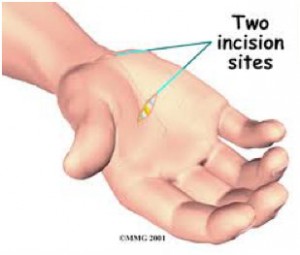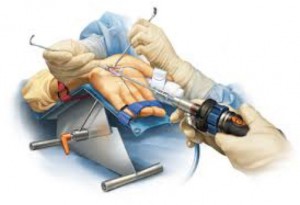Carpal Tunnel Release–Arthroscopic
Carpal Tunnel Release-Endoscopic surgery uses a thin, flexible tube with a camera attached (endoscope). The endoscope is guided through a small incision in the wrist (single-portal technique) or at the wrist and palm (two-portal technique). The endoscope lets the doctor see structures in the wrist, such as the transverse carpal ligament, without opening the entire area with a large incision.
 Preparation for Carpal Tunnel Release Surgery
Preparation for Carpal Tunnel Release Surgery
Endoscopic Carpal tunnel surgery is usually performed on an outpatient basis, meaning that you go home the day of your surgery. For your particular situation, you will be given specific instructions as to where and when to arrive at the medical facility, how to prepare for your surgery, and what to expect the day of and in the days following your surgery.
- You will be asked not to eat or drink anything for at least eight hours before carpal tunnel Additionally, dietary restrictions may be made by your doctor.
- Due to medications often used for this procedure, you will not be able to drive for at least 24 hours afterward.
- Be sure to arrange for someone to drive you home.
Carpal Tunnel Release- Endoscopic Surgery
The median nerve and the tendons that flex (or curl) your fingers go through a passage called the carpal tunnel in your wrist. This tunnel is narrow, so any swelling can pinch the nerve and cause pain. A thick ligament (tissue) just under your skin (the carpal ligament) makes up the top of this tunnel.
First, you will receive numbing medicine so that you will not feel pain during surgery. You may be awake but you will also receive medicines to make you relax.
The surgeon will cut through the carpal ligament to make more space for the nerve and tendons. To do this:
- First, a small surgical cut is made in the palm of your hand near your wrist.
- Next, the ligament that covers the carpal tunnel is cut. This eases the pressure on the median nerve. Sometimes, tissue around the nerve is removed as well.
- The skin and tissue underneath your skin are closed with sutures (stitches).
 The surgeons do this procedure using a tiny camera that is attached to a monitor. The surgeon inserts the camera into your wrist through a very small surgical cut and views the monitor to see inside your wrist. This is called endoscopic surgery. The instrument used is called an endoscope.
The surgeons do this procedure using a tiny camera that is attached to a monitor. The surgeon inserts the camera into your wrist through a very small surgical cut and views the monitor to see inside your wrist. This is called endoscopic surgery. The instrument used is called an endoscope.
Carpal Tunnel Release- Endoscopic Surgery Recovery
This surgery is done on an outpatient basis. You will not need to stay in the hospital. After the surgery, your wrist will probably be in a splint or heavy bandage for about a week. Keep this on until your first doctor visit after surgery, and keep it clean and dry. After the splint or bandage is removed, you will begin motion exercises or a physical therapy program.
Risks of the Procedure
Risks of Carpal Tunnel Release-Endoscopic are:
- Allergic reactions to medicines
- Bleeding
- Infection
- Injury to the median nerve or nerves that branch off of it
- Weakness and numbness around the hand
- Rarely, injury to another nerve or blood vessel (artery or vein)
- Scar Tenderness
